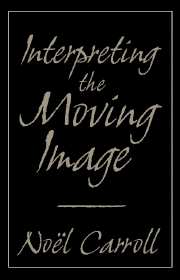Book contents
- Frontmatter
- Contents
- Foreword: Through Carroll's Looking Glass of Criticism
- Introduction
- 1 The Cabinet of Dr. Kracauer
- 2 Entr'acte, Paris and Dada
- 3 The Gold Rush
- 4 Keaton: Film Acting as Action
- 5 Buster Keaton, The General, and Visible Intelligibility
- 6 For God and Country
- 7 Lang, Pabst, and Sound
- 8 Notes on Dreyer's Vampyr
- 9 King Kong: Ape and Essence
- 10 Becky Sharp Takes Over
- 11 Interpreting Citizen Kane
- 12 The Moral Ecology of Melodrama: The Family Plot and Magnificent Obsession
- 13 Mind, Medium, and Metaphor in Harry Smith's Heaven and Earth Magic
- 14 Welles and Kafka
- 15 Nothing But a Man and The Cool World
- 16 Identity and Difference: From Ritual Symbolism to Condensation in Anger's Inauguration of the Pleasure Dome
- 17 Text of Light
- 18 Joan Jonas: Making the Image Visible
- 19 Introduction to Journeys from Berlin/1971
- 20 The Future of Allusion: Hollywood in the Seventies (and Beyond)
- 21 Back to Basics
- 22 Amy Taubin's Bag
- 23 Herzog, Presence, and Paradox
- 24 Film in the Age of Postmodernism
- Notes
- Index
11 - Interpreting Citizen Kane
Published online by Cambridge University Press: 05 June 2012
- Frontmatter
- Contents
- Foreword: Through Carroll's Looking Glass of Criticism
- Introduction
- 1 The Cabinet of Dr. Kracauer
- 2 Entr'acte, Paris and Dada
- 3 The Gold Rush
- 4 Keaton: Film Acting as Action
- 5 Buster Keaton, The General, and Visible Intelligibility
- 6 For God and Country
- 7 Lang, Pabst, and Sound
- 8 Notes on Dreyer's Vampyr
- 9 King Kong: Ape and Essence
- 10 Becky Sharp Takes Over
- 11 Interpreting Citizen Kane
- 12 The Moral Ecology of Melodrama: The Family Plot and Magnificent Obsession
- 13 Mind, Medium, and Metaphor in Harry Smith's Heaven and Earth Magic
- 14 Welles and Kafka
- 15 Nothing But a Man and The Cool World
- 16 Identity and Difference: From Ritual Symbolism to Condensation in Anger's Inauguration of the Pleasure Dome
- 17 Text of Light
- 18 Joan Jonas: Making the Image Visible
- 19 Introduction to Journeys from Berlin/1971
- 20 The Future of Allusion: Hollywood in the Seventies (and Beyond)
- 21 Back to Basics
- 22 Amy Taubin's Bag
- 23 Herzog, Presence, and Paradox
- 24 Film in the Age of Postmodernism
- Notes
- Index
Summary
Citizen Kane is a film that has engendered a classic conflict of interpretation. That is, there are at present two leading views of its thematic point, and these two views appear, on the surface, to be incompatible. These two interpretations can be called the enigma interpretation, on the one hand, and the Rosebud interpretation, on the other. Each interpretation is quite simple, and, I shall argue, its simplicity is important to the function it actually plays in Citizen Kane. The enigma interpretation says that Citizen Kane illustrates the point that the nature of a person is ultimately a mystery; a person is all things to all persons, and, correspondingly, a multiplicity of selves. The Rosebud interpretation says that Kane's personality is finally explicable by some such notions as those of “lost childhood” or “lost innocence.” I hasten to add that many commentators may, strangely enough, fail to see that these interpretations of Citizen Kane are incompatible. But they obviously are: if human life is inexplicable in the way the enigma interpretation says, then a life like Kane's cannot be explained in terms of a clue like Rosebud. Or, alternatively, if Rosebud yields a convincing explanation of Kane's life, then Kane's life, and, by extension, human life in general is not inevitably inexplicable, i.e., not unavoidably enigmatic.
A recent defense of the enigma view, one that is aware of its incompatibility with the Rosebud view, can be found in Ian Jarvie's Philosophy of the Film.
- Type
- Chapter
- Information
- Interpreting the Moving Image , pp. 153 - 165Publisher: Cambridge University PressPrint publication year: 1998

